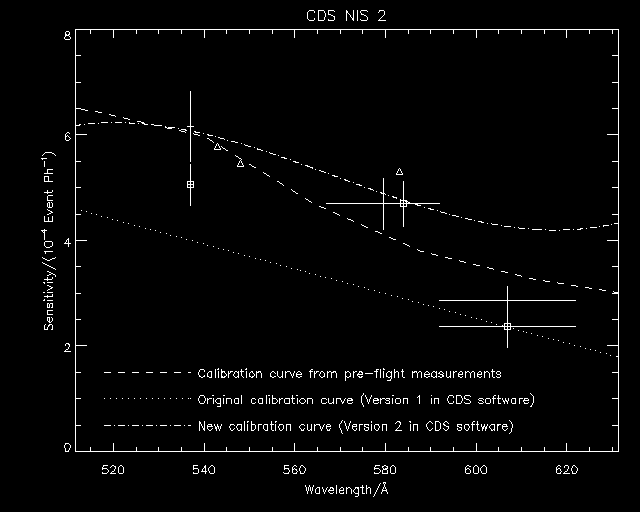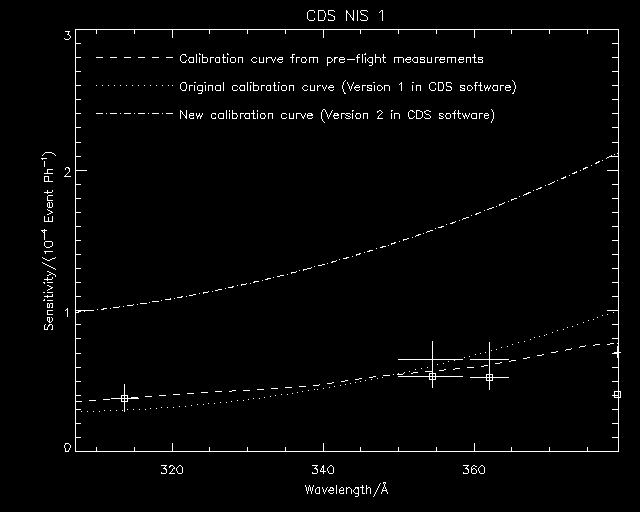

 |
Software |  |
|
CDS NIS Calibration Introduction CDS was calibrated pre-launch using a transfer standard source. Following launch, an in-fight calibration was estimated from the preliminary report on the calibration (Bromage et al. 1996) and the work leading to the publication by Landi et al. (1997) and shown by them in their table 1 and figure 1. Since then the calibration report has been finished (Lang et al. 1999). This contains, inter alia, a re-evaluation of the laboratory measurements and gives the wavelength dependence of that calibration. In addition the CDS NIS calibration has been compared to that obtained by a calibration rocket (Brekke et al. 1999). NIS 2 First Order The pre-launch calibration of CDS (Lang et al. 1999) indicated that the absolute responsivity in the NIS 2 spectral waveband was known to ± 30% when the uncertainties in the aperture determination ( ± 8%), the events to photon conversion factor ( ± 23%), the detector operating voltage change between laboratory and in-flight use ( ± 16%) and the calibration (from a synchrotron source) of the secondary standard source used ( ± 7%) are combined. Brekke et al. (1999) report comparisons of in-flight measurements using CDS to simultaneous measurements from a NASA/LASP sounding rocket experiment (EGS) which had been calibrated against a synchrotron (Woods et al. 1994, Woods et al. 1997). These measurements gave a calibration of CDS NIS 2 varying in uncertainty from ± 15% at 584 Å to ± 25% at either end of the NIS 2 waveband. Although the laboratory NIS 2 events to photon conversion was taken overall to be ± 23%, the measurement point at 584 Å was estimated to be correct to ± 9% yielding (4.70 ± 0.42)x10 -4 events/photon while the comparison with the rocket spectra gave (4.75 ± 0.71)x10 -4, in excellent agreement. The calibration adopted for CDS NIS 2 is that derived by Brekke et al. (1999).
 shows the various NIS 2 calibrations. The laboratory calibration points are plotted with error bars along with the pre-flight calibration curve (Lang et al 1999). The original CDS in-flight calibration (version 1 in the CDS software) is shown along with the new calibration from the work of Brekke et al. (1999) (in the software as version 2). NIS 1 - First order For NIS 1, the overall uncertainty for the pre-launch calibration of CDS (Lang et al. 1999) indicated that the absolute responsivity in the NIS 1 spectral waveband was also ± 30%, in this case the events/photon having an uncertainty of ± 25%. The comparison of CDS and the rocket experiment spectra only yielded one comparison point, for Mg IX 368 Å . There the events/photon were (1.86 ± 0.46)x10-4. The laboratory calibration gave (6.77 ± 1.69)x10 -5 which is about a factor three lower. In doing the calibration work for NIS 2 it was possible to observe the source spot image using the largest slit and the very bright He I 584 Å line. However, for NIS 1 no single isolated and bright enough line was available to check the alignment. The difference in laboratory and in-flight calibration is consistent with, and is attributed to, undetected misaligment during the NIS 1 laboratory work. Other sources of disprepancy which would cause a change in NIS 1 but not NIS 2 are discussed in Lang et al. (1999) in their comparison of the laboratory and predicted events/photon conversions. These other sources can also be ruled out in the present case. The adopted in-flight calibration is thus the point obtained for the 368 Å line from comparison with the rocket experiment. This is extended to other wavelengths by adopting the slope of the laboratory measurements. A misalignment should not affect the slope of the laboratory events/photon versus wavelength conversion. The events/photon uncertainty is taken as ± 25% close to 368 Å otherwise ± 45% is assigned. The comparison of CDS measurements with those from the 1997 flight of the SERTS rocket will allow a more accurate NIS 1 event/photon conversion to be established.
 Shows the various NIS 1 calibrations. The laboratory calibration points are plotted with error bars along with the pre-flight calibration curve (Lang et al 1999). The original CDS in-flight calibration (version 1 in the CDS software) is shown along with the new calibration from the work of Brekke et al. (1999) (in the software as version 2). Comparison with SUMER Intercalibration studies of NIS2 with SUMER have been analysed and are reported in Pauluhn et al. (1999). They show that CDS measures generally a 30% higher intensity than SUMER in the He I 584 Å line, while it measures 9% and 17% higher intensities in Mg X 609 Å and Mg X 624 Å, respectively. Both instruments are shown to have a very good temporal correlation and stability, indicating that solar variations dominate over changes in instrumental sensitivity for the intercalibration datasets. Software The implementation of these calibrations has been described in an email message from Bill Thompson. It is important to note that any raw data run through the current software will use the LATEST calibration values irrespective of the observation date, but instrumental effects (eg MCP burn in) will always relate to the actual observation date. There has always been the facility to retrieve earlier intensity calibrations (see Bill's note), but that feature was at a fairly low level - ie as a keyword to the database access routines. There is, however, a routine QCALIB (currently in /cs/update) which allows an easy, quick comparison for any particular date.
Eg. the command IDL> qcalib, '1997/10/1' would produce the following plot. References
Brekke P, Thompson W T, Woods T N and Eparvier F G 1999, in prep.
|